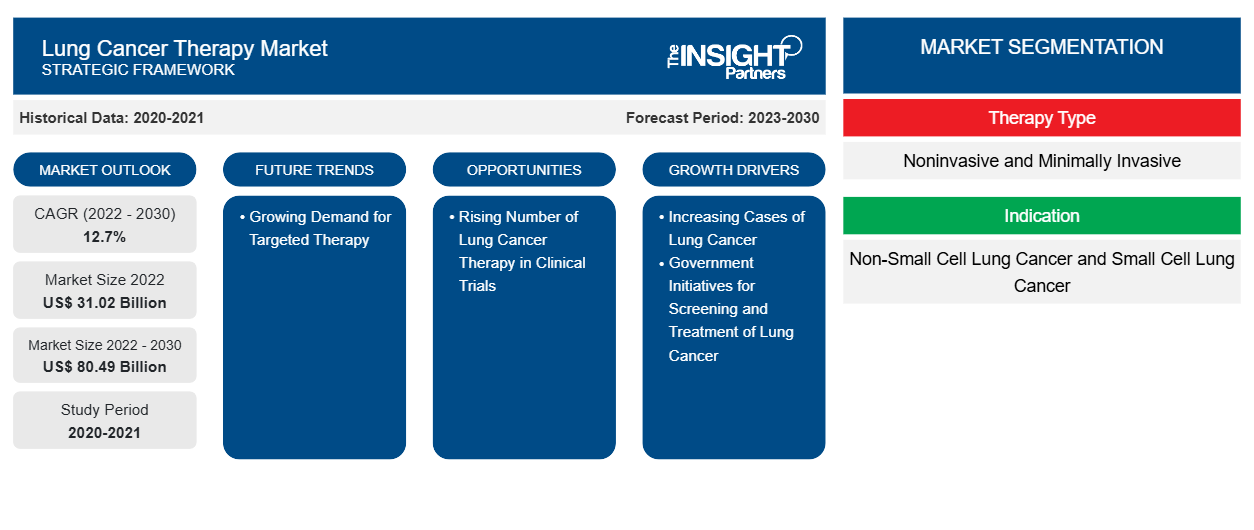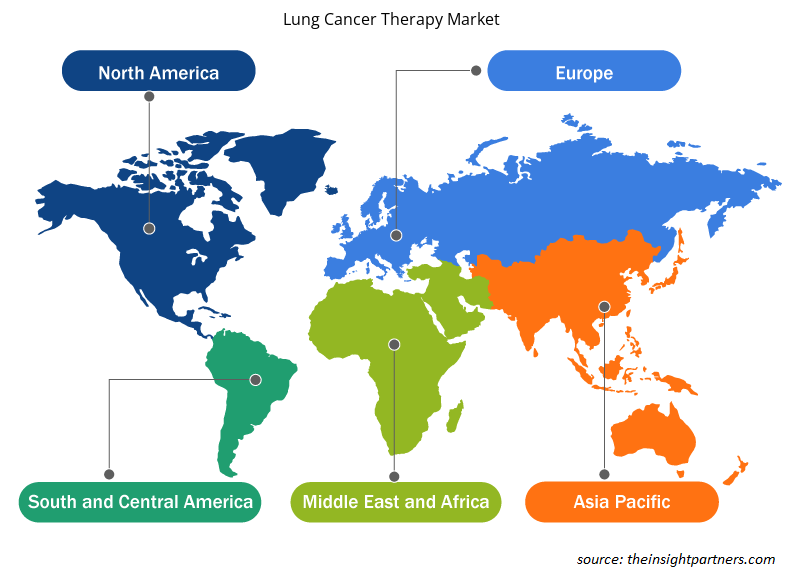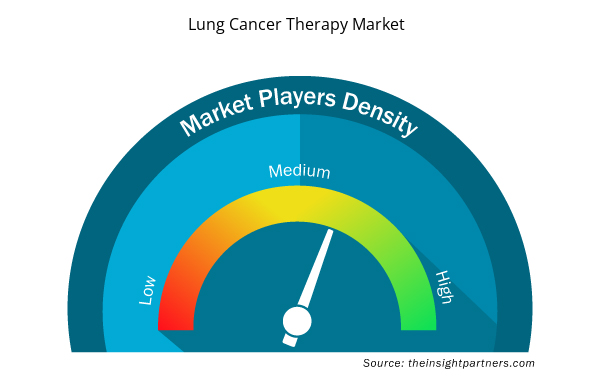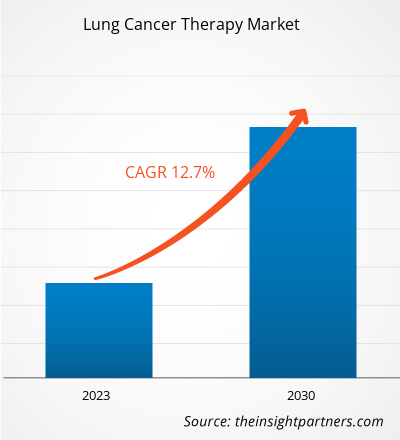[Research Report] The lung cancer therapy market is expected to grow from US$ 31,018.32 million in 2022 to US$ 80,493.84 million by 2030; it is anticipated to record a CAGR of 12.7% from 2022 to 2030.
Market Insights and Analyst View:
The lung cancer therapy market size is expanding with the rising cases of lung cancer, and the increasing habit of smoking and tobacco consumption in countries such as the UK, Germany, the US, and India. ~48,000 people get diagnosed with lung cancer, and ~35,000 people die yearly because of the disease in the UK. Smoking is the most common cause of lung cancer, while other causes include passive smoking and exposure to certain gases and chemicals. Currently, every fourth man (~27.0%) and every fifth woman (~21%) in Germany smokes regularly. The current landscape for lung cancer therapies is promising, with multiple drug approvals, a rich pipeline, and many ongoing clinical trials. Multiple lung cancer therapies are in various stages of clinical development; pharmaceutical giants are working to expand their pipeline, which is a major opportunity prevailing in the lung cancer therapy market
Growth Drivers and Challenges:
Lung cancer is among the main causes of mortality across the world. This type of cancer can be treated more effectively if it is diagnosed early. Therefore, people at a high risk of lung cancer need to undergo routine testing to detect the formation of cancerous growth inside their lungs. Globally, lung cancer is the most common cancer in men and the second most common cancer in women. According to the World Health Organization (WHO), lung cancer is the leading cause of cancer-related deaths worldwide, in both men and women. As per the World Cancer Research Fund International, ~2.2 million new lung cancer cases were registered worldwide in 2020.
According to the American Cancer Society’s estimates for lung cancer in the US, ~238,340 new lung cancer cases are likely to be registered in 2023, including 120,790 women and 117,550 men. Also, according to the National Center for Biotechnology Information (NCBI), ~41,000 new diagnoses of lung cancers and ~34,000 deaths are recorded yearly in Italy. As per the Cancer Australia 2023 report, ~14,529 new lung cancer cases were diagnosed in 2022, which included 7,707 males and 6,822 females. Nearly 9% of new cancer cases were diagnosed in 2022, with an estimated 8,664 deaths. Data provided by the Health Ministry of Turkey states that ~23,000 men and ~4,500 women are diagnosed with lung cancer annually in Turkey. Thus, the rising incidence of lung cancer worldwide is contributing to the research and development activities for lung cancer therapy, which is, in turn, driving the market growth.
Since 1995, there has been a marked increase in the prices of new cancer drugs due to the acceptance of biologics in of biologics in oncology. In the US, the monthly cost incurred for the treatment of cancer is ~US$ 100,000. Cancer drug prices are the highest in the country; the drugs are more than two-fold costlier than those in Europe and two- to six-times more expensive than those in the rest of the world. The cost of lung cancer treatments in a few of the countries is given below:
Country | Range of Treatment Cost |
India | INR 100,000–2,00,000 (US$ 1,203.01–2,406.02) |
US | US$ 25,000 to US$ 50,000 |
Nigeria | ₦5,540,000–9,000,000 (US$ 721.56–1,172.2) |
Kenya | KES.100,000–300,000 (US$ 668.22–2,004.66) |
Ghana | GHS 80,000–2,00,000 (US$ 6,823.44–17,058.6) |
Turkey | Liras 180,000–22,000 (US$ 6,512–7,959.12) |
Germany | €18,000–25,000 (US$ 19,046.5–26,453.5) |
The monthly cost of many anticancer drugs greatly exceeds most household incomes. Thus, there is a huge pressure on researchers to limit costs and demonstrate value. Political uncertainty and persistent economic stress in many countries are raising concerns about the sustainability of public health care funding. In less wealthy countries, the lack of cost-effective drugs influences the health conditions of populations, resulting in a low average life expectancy. In countries without universal healthcare and healthcare coverage providers, patients have to pay out-of-pocket for their treatments. The high costs associated with drugs are limiting the revenues of oncology drug manufacturers by limiting their access to only the wealthy population and people who have effective insurance coverage. Thus, the high cost of drugs and surgeries hampers the lung cancer therapy market growth.
Customize This Report To Suit Your Requirement
You will get customization on any report - free of charge - including parts of this report, or country-level analysis, Excel Data pack, as well as avail great offers and discounts for start-ups & universities
Lung Cancer Therapy Market: Strategic Insights

- Get Top Key Market Trends of this report.This FREE sample will include data analysis, ranging from market trends to estimates and forecasts.
Customize This Report To Suit Your Requirement
You will get customization on any report - free of charge - including parts of this report, or country-level analysis, Excel Data pack, as well as avail great offers and discounts for start-ups & universities
Lung Cancer Therapy Market: Strategic Insights

- Get Top Key Market Trends of this report.This FREE sample will include data analysis, ranging from market trends to estimates and forecasts.
Report Segmentation and Scope:
The lung cancer therapy market is divided on the basis of therapy type, indication, end user, and geography. The lung cancer therapy market, by vaccine type, is bifurcated into noninvasive and minimally invasive. The minimally invasive segment is further classified into radiofrequency ablation, microwave ablation, thermal ablation, cryoablation, chemical ablation, photodynamic ablation, and others. The lung cancer therapy market, by indication, is segmented into non-small cell lung cancer and small cell lung cancer. The market, by end user, is segmented into hospitals, oncology clinics, research centers, and others. Based on geography, the lung cancer therapy market is segmented into North America (US, Canada, and Mexico), Europe (UK, Germany, France, Italy, Spain, Russia, and Rest of Europe), Asia Pacific (China, Japan, India, South Korea, Australia, Southeast Asia, and Rest of Asia Pacific), the Middle East & Africa (UAE, Saudi Arabia, South Africa, and Rest of Middle East & Africa), and South & Central America (Brazil, Argentina, and Rest of South & Central America).
Segmental Analysis:
The lung cancer therapy market, by vaccine type, is segmented into noninvasive and minimally invasive. The minimally invasive segment is further classified into radiofrequency ablation, microwave ablation, thermal ablation, cryoablation, chemical ablation, photodynamic ablation, and others. In 2022, the noninvasive therapy segment held a larger market share. The minimally invasive segment is expected to record a higher CAGR during 2022–2030. Radiation therapy, chemotherapy, and targeted therapy are the major types of noninvasive lung cancer therapies. Radiation lung cancer therapy uses high energy and powerful X-rays to eliminate the cancerous cells, control their growth, and stop their spread within the lungs. Radiation therapy is used before and after surgeries to shrink the tumor before surgery and kill the persistent cancer cells after surgeries. In chemotherapy, drugs are used to kill the new or existing cancerous cells in the lungs. Chemotherapy is considered an important treatment for lung cancer. According to the article “Chemotherapy Statistics” published in 2023, approximately 2% of stage 1 and 2 patients, 9% of stage 3 patients, and 27% of stage 4 patients receive chemotherapy for treatment of their lung cancer, respectively.
The minimally invasive segment is further segmented into radiofrequency ablation, microwave ablation, thermal ablation, cryoablation, chemical ablation, photodynamic ablation, and others. Photodynamic ablation is an underutilized therapy that leads to the selective destruction of cancer cells by the production of reactive oxygen. This type of therapy has been extensively studied clinically as well as in in-vitro environments. Various research studies have been conducted for checking the efficacy of photodynamic ablation therapy in combination with nanoparticles in lung cancer patients.
Radiofrequency ablation (RFA) is the latest and most promising treatment for cancer patients, including inoperable NSCLC patients. With high feasibility and safety, RFA can cause irreversible injury or coagulation necrosis to tumors by utilizing the biological effects of heat. In recent years, more hospitals have started choosing RFA rather than stereotactic body radiotherapy (SBRT) as a nonsurgical treatment option for early-diagnosed NSCLC. Thus, increasing research activities in photodynamic ablation therapy and a growing preference for radiofrequency ablation therapy are fueling the growth of the lung cancer therapy market for the RFA segment. The microwave ablation technique uses a thin needle to transmit microwaves into liver tumors to destroy cancer cells with heat.
Chemical ablation is the technique in which a chemical mixture is injected into the vein, followed by observing it using ultrasound imaging. The application and combination of different drugs, from anhydrous ethanol and glacial acetic acid to epi-amycin, have been clinically tested for a long time.
Regional Analysis:
Based on geography, the lung cancer therapy market is divided into North America, Europe, Asia Pacific, the Middle East & Africa, and South & Central America. North America is the largest contributor to the growth of the global lung cancer therapy market. Asia Pacific is expected to register the highest CAGR in the lung cancer therapy market during 2022–2030. The growth of the lung cancer therapy market in the US is mainly driven by the increasing incidence of lung cancer cases, product launches, and government initiatives. Lung cancer is the second most common cancer in the US. As per the American Cancer Society, Inc., as of 2023, ~238,340 adults (117,550 men and 120,790 women) in the US have been diagnosed with lung cancer; also, ~127,070 (67,160 in men and 59,910 in women) have succumbed to death due to the disease. Lung cancer accounts for 1 in 5 of all cancer deaths, making it a leading cause of cancer death in the US. As per the same source, NSCLC accounts for 81% of all lung cancer diagnoses. Thus, the increasing incidence of lung cancer in the country fuels the growth of the US lung cancer therapy market.
Various product launches for the treatment of lung cancer by companies are also bolstering the market growth. In May 2021, the US FDA approved Lumakras (sotorasib) as the first targeted therapy for adult non-small cell lung cancer patients. This is the first targeted therapy approved for tumors with KRAS mutation, which accounts for ~25% of the mutations reported in non-small cell lung cancer (NSCLC) cases. In May 2021, the US FDA granted accelerated approval to Rybrevant (amivantamab-vmjw), a bispecific antibody directed against epidermal growth factor (EGF) and MET receptors in adult patients with locally advanced or metastatic NSCLC that comprises EGFR exon 20 insertion mutations.
Lung Cancer Therapy Market Regional Insights
Lung Cancer Therapy Market Regional Insights
The regional trends and factors influencing the Lung Cancer Therapy Market throughout the forecast period have been thoroughly explained by the analysts at Insight Partners. This section also discusses Lung Cancer Therapy Market segments and geography across North America, Europe, Asia Pacific, Middle East and Africa, and South and Central America.

- Get the Regional Specific Data for Lung Cancer Therapy Market
Lung Cancer Therapy Market Report Scope
| Report Attribute | Details |
|---|---|
| Market size in 2022 | US$ 31.02 Billion |
| Market Size by 2030 | US$ 80.49 Billion |
| Global CAGR (2022 - 2030) | 12.7% |
| Historical Data | 2020-2021 |
| Forecast period | 2023-2030 |
| Segments Covered |
By Therapy Type
|
| Regions and Countries Covered | North America
|
| Market leaders and key company profiles |
Lung Cancer Therapy Market Players Density: Understanding Its Impact on Business Dynamics
The Lung Cancer Therapy Market market is growing rapidly, driven by increasing end-user demand due to factors such as evolving consumer preferences, technological advancements, and greater awareness of the product's benefits. As demand rises, businesses are expanding their offerings, innovating to meet consumer needs, and capitalizing on emerging trends, which further fuels market growth.
Market players density refers to the distribution of firms or companies operating within a particular market or industry. It indicates how many competitors (market players) are present in a given market space relative to its size or total market value.
Major Companies operating in the Lung Cancer Therapy Market are:
- Medtronic PLC
- RF Medical Co Ltd
- Johnson & Johnson
- Merck KGaA
- Sun Pharmaceutical Industries Ltd
Disclaimer: The companies listed above are not ranked in any particular order.

- Get the Lung Cancer Therapy Market top key players overview
Industry Developments and Future Opportunities:
Various initiatives by key players operating in the Lung Cancer Therapy Market are listed below:
- In October 2023, Johnson & Johnson submitted the Type II extension of indication application seeking approval of the European Medicines Agency (EMA) for the use of RYBREVANT (amivantamab) in combination with chemotherapy (carboplatin and pemetrexed) as the first-line treatment of adult patients with advanced non-small cell lung cancer (NSCLC) with activating epidermal growth factor receptor (EGFR) exon 20 insertion mutations.
- In December 2022, RF Medical Co Ltd announced that the FDA approved their patented MYGEN M-3004 generator and MYOBLATE radiofrequency ablation system for commercialization in the US. These devices are used to treat damaged tumors and tissues.
- May 2021, Janssen Pharmaceutical Companies of Johnson & Johnson announced that the US FDA granted the accelerated approval of RYBREVANTTM (amivantamab-vmjw) for the treatment of adult patients with locally advanced or metastatic non-small cell lung cancer (NSCLC) with EGFR exon 20 insertion mutations. The drug is indicated among patients showing disease progression on or after platinum-based chemotherapy. RYBREVANTTM is the first fully-human, bispecific antibody approved for the treatment of patients with NSCLC that targets EGFR exon 20 insertion mutations, which are the third most prevalent activating EGFR mutation.
Competitive Landscape and Key Companies:
A few of the prominent players operating in the lung cancer therapy market are Medtronic PLC, RF Medical Co Ltd, Johnson & Johnson, Merck KGaA, Sun Pharmaceutical Industries Ltd, Bioventus Inc, Meiji Seika Pharma Co Ltd, Advanz Pharma Corp, and Olympus Corp. These companies focus on new product launches and geographic expansions to meet the growing consumer demand worldwide and increase their product range in specialty portfolios. Their global presence allows them to serve a large base of customers, subsequently facilitating market expansion.
- Historical Analysis (2 Years), Base Year, Forecast (7 Years) with CAGR
- PEST and SWOT Analysis
- Market Size Value / Volume - Global, Regional, Country
- Industry and Competitive Landscape
- Excel Dataset


- Intraoperative Neuromonitoring Market
- MEMS Foundry Market
- Water Pipeline Leak Detection System Market
- Retinal Imaging Devices Market
- Portable Power Station Market
- Electronic Shelf Label Market
- Wind Turbine Composites Market
- Occupational Health Market
- Investor ESG Software Market
- Playout Solutions Market

Report Coverage
Revenue forecast, Company Analysis, Industry landscape, Growth factors, and Trends

Segment Covered
Therapy Type, Indication, End User, and Geography

Regional Scope
North America, Europe, Asia Pacific, Middle East & Africa, South & Central America

Country Scope
This text is related
to country scope.
Frequently Asked Questions
The lung cancer therapy market is analyzed on the basis of disease indication, type, offering, technology, and end user. Based on therapy type, the lung cancer therapy market is segmented into non-invasive and minimally invasive. Minimally Invasive segment is further classified into radiofrequency ablation, microwave ablation, thermal ablation, cryoablation, chemical ablation, photodynamic ablation, and others. In 2022, the noninvasive therapy segment held a larger market share. The minimally invasive segment is expected to record a higher CAGR during 2022–2030.
The lung cancer therapy market majorly consists of the players such Medtronic PLC, RF Medical Co Ltd, Johnson & Johnson, Merck KGaA, Sun Pharmaceutical Industries Ltd, Bioventus Inc, Meiji Seika Pharma Co Ltd, Advanz Pharma Corp, and Olympus Corp among others.
The increasing cases of lung cancer, and government initiatives for the screening and treatment of lung cancer bolster the lung cancer therapy market size. However, the high cost of lung cancer therapy hinders the lung cancer therapy market growth.
The most common treatment for lung cancer includes surgery, radiotherapy, chemotherapy, and immunotherapy. Lung cancer now a days is treated by targeted therapy, a type of personalized medicine, is a combination of two or more drugs, designed to directly target the cancerous cells. Therapies such as ablation and chemotherapy destroy healthy cells along with infected cells, which can affect the overall patient condition. Targeted therapy is designed in a way to selectively kill cancerous cells, keeping the function of healthy cells unhampered. With recent developments in medical technologies, focus on the use of targeted therapy for the treatment of lung cancer is increasing notably. Scientists are focusing on studying lung cancer cell mutations that are responsible for driving the uncontrolled growth of cancerous cells.
Trends and growth analysis reports related to Life Sciences : READ MORE..
The List of Companies - Lung Cancer Therapy Market
- Medtronic PLC
- RF Medical Co Ltd
- Johnson & Johnson
- Merck KGaA
- Sun Pharmaceutical Industries Ltd
- Bioventus Inc
- Meiji Seika Pharma Co Ltd
- Advanz Pharma Corp
- Olympus Corp

 Get Free Sample For
Get Free Sample For